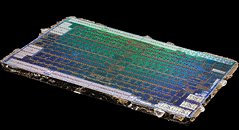Tuesday, September 25th 2018

Clues Gather Regarding Possible New AMD Polaris (Re)Revision Launch
Clues have been popping here and there regarding a possible new Polaris revision being launched by AMD in the (relatively) near future. Speculation first reared its head regarding a revised "Polaris 30" silicon, allegedly being built for TSMC's 12 nm process - not unlike AMD's 2000-series Ryzen CPUs. The company has been enamored with trying out and adapting new foundry processes for its products as soon as possible, now that they've found themselves fabless and not having to directly support the R&D costs necessary for process node development themselves.
Some publications are pointing towards a 15% performance improvement being achieved on the back of this process change for Polaris - which, if achieved only via a new process implementation, would require clock speed increases that are higher than that. AMD has already launched their revised Polaris 20 RX 500 series, which built upon their RX 400 series (and Polaris 10) by upping the clocks as well. A smaller node would likely be associated with higher yields and decreased costs per finished chip, which would allow AMD to further reduce pricing/stabilize pricing while introducing a new product generation to tide users over until Navi is finally ready.Adding to all of this (and the included NaCl), a post via Phoronix has been posted which speaks of a new Polaris Device ID (0x6FDF) that's being added to the latest AMDGPU Linux kernel patch. The new device ID is being added under the "POLARIS 10" family, which includes the Polaris 20 revision. We'll see how this pans out, but if AMD are to in fact revise their Polaris architecture for the 12 nm node, some architectural changes likely wouldn't go wrong to extract maximum value out of that investment.
Sources:
ChipHell, via WCCFTech, Phoronix, Linux Patch
Some publications are pointing towards a 15% performance improvement being achieved on the back of this process change for Polaris - which, if achieved only via a new process implementation, would require clock speed increases that are higher than that. AMD has already launched their revised Polaris 20 RX 500 series, which built upon their RX 400 series (and Polaris 10) by upping the clocks as well. A smaller node would likely be associated with higher yields and decreased costs per finished chip, which would allow AMD to further reduce pricing/stabilize pricing while introducing a new product generation to tide users over until Navi is finally ready.Adding to all of this (and the included NaCl), a post via Phoronix has been posted which speaks of a new Polaris Device ID (0x6FDF) that's being added to the latest AMDGPU Linux kernel patch. The new device ID is being added under the "POLARIS 10" family, which includes the Polaris 20 revision. We'll see how this pans out, but if AMD are to in fact revise their Polaris architecture for the 12 nm node, some architectural changes likely wouldn't go wrong to extract maximum value out of that investment.

58 Comments on Clues Gather Regarding Possible New AMD Polaris (Re)Revision Launch
This is going to be another underwhelming die-shrink of Polaris to give AMD's GPU division some sort of method for competing with Pascal/Turing over the holiday season, by launching "new" cards with a larger first digit model number than their "old" cards. If they can drop the price low enough it should be sufficient to steal some of the GTX 1060's thunder.
maybe 5-10% performance increase with AMD pushing the clock rates beyond the limits thereby having like 220W same as rtx 2080( because rx 580 = gtx 1080 in efficiency) power consumption for card only
thereby making it DOA...
I'm not sure we can expect 10-15% improvement from this alone.
And BTW, GTX 1080 is about 80% more efficient than RX 580.Because that would require rebalancing of the whole GPU. Taking a Vega10 and scaling it down would probably work much better than scaling Polaris up. Still, the greater problem for AMD isn't lack of theoretical performance, it's lack of utilization. RX 580 already have 50% more GFlop/s and 18% memory bandwidth than GTX 1060 which beats it, so there isn't a lack of resources. Adding more cores without also improving the scheduling will result in reduced efficiency for very marginal performance gains.
There's also the more pertinent fact that AMD has finally realised that ploughing money into the dead end that is GCN is a waste, so there's no possibility of a Vega redesign... maybe a respin, maybe maybe Vega 20 consumer parts at best.
and is now picking up steam in 2017/18
www.techpowerup.com/gpuz/details/aemqn
Deliver a full "Polaris 30" that's a 1440p darling for all the 27-32" FreeSync monitors and price it the same MSRP at $230. For the 570 replacement make the 4Gb (GDDR6) as the "end-all-be-all 1080p card" most gamers need (kind of what a 7770 did for anything less than 1080p) and promote how it runs most anything silky-smooth with a FreeSync 1080p monitor and price it at $160.
There's a ton of gamers that have been making due with cards that they bought after the first mining bust of 2014-15 and have of yet seen prices/performance be good enough to take the leap, especially given both sides are still hawking tech that's now approaching 2-1/2 years.
I find the general silence telling, though. Probably smart to play the waiting game right now. I'm not convinced they're even looking to compete right now. I mean, no matter what they were to build people up to right now, it wouldn't be enough. I'm betting they're not hyping things up because they know they have no answer to RTX at the moment, though no doubt we will know when they do. Wouldn't be surprised if they dropped something with no fanfare between then and now, as they have done before.
I dunno, not thinking anything of them one way or another right now.